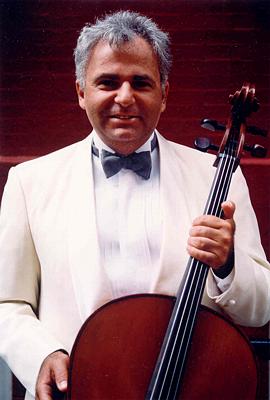|

Artistic vision
Russian musicians bring soul to Shostakovich,
by LAWRENCE BUDMEN
Few composers musically portrayed the agonies of human suffering in the 20th century like Dimitri Shostakovich (1906-1975). Repeatedly denounced by the Soviet regime, Shostakovich wrote music of brooding intensity, frightening violence, and harmonic astringency. He was one of the creative giants and one of the most distinctive, original voices of his time. In his Seventh and Eighth Symphonies Shostakovich gave musical life to the siege of Leningrad and the battle of Stalingrad -- two of Russia's greatest tragedies and ultimate triumphs. In his Thirteenth Symphony the composer set Yevtuchenko's poem Babi-Yar which vividly dramatized Russian anti-Semitic atrocities. Shostakovich's post World War II Trio for Violin, Cello, and Piano, Op 67, is a bleak, driven work that was inspired by the inhumanity of the Holocaust. A dramatic, deeply emotional performance of that masterwork formed the climax of Festival Miami's Evening of Russian Music on 28 September 2005 at the University of Miami Gusman Concert Hall in Coral Gables, Florida, USA.

Semyon Fridman
|
One of Shostakovich's angriest works, the Trio paints a desolate musical landscape. From the sparse textures of the opening Andante to the fierce, headlong fury of the Allegro non troppo (Scherzo) and the passionate, somber requiem of the profoundly moving Largo, this score sings deep from within the Russian soul. In the final Allegretto Shostakovich turns to a thematic motive that Nazi concentration camp guards forced inmates to sing as they dug their own graves. This is music of utter desolation. A less than musically impeccable, totally committed performance of this work would fail to communicate the composer's agony, conscience stricken angst, and deep humanity. Pianist (and UM music professor) Paul Posnak joined Russian artists Sviatoslav Moroz (violinist) and Semyon Fridman (cellist) for a briskly pensive and intense performance. They did not attempt to prettify the music. The painful resignation of the slow movement and the darkly rhythmic dance of death of the finale were imbued with fire driven momentum. Posnak's lithe, brilliant pianism, Fridman's amber toned, aristocratic cello, and Moroz's wiry Gypsy violin brought burning intensity of the most kinetic variety to this performance. A singular artistic vision in a one of a kind, truly memorable interpretation!
Continue >>
Copyright © 6 October 2005
Lawrence Budmen, Miami Beach, USA

|

